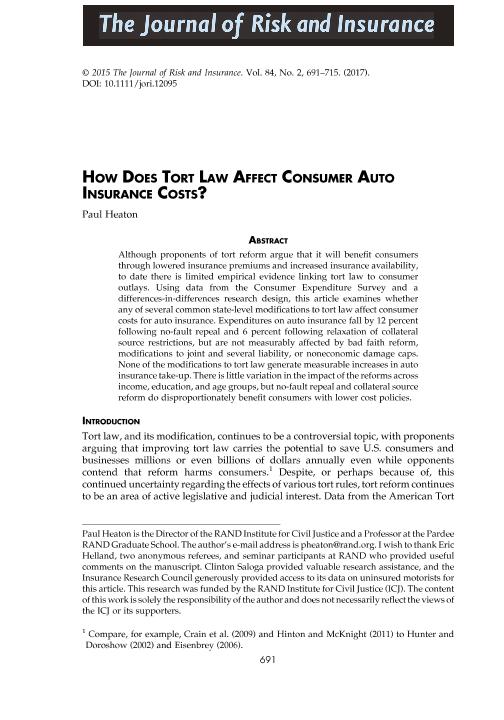How does Tort Law affect consumer auto insurance costs?

Contenido multimedia no disponible por derechos de autor o por acceso restringido. Contacte con la institución para más información.
| Tag | 1 | 2 | Value |
|---|---|---|---|
| LDR | 00000cab a2200000 4500 | ||
| 001 | MAP20170019572 | ||
| 003 | MAP | ||
| 005 | 20170619144931.0 | ||
| 008 | 170613e20170605esp|||p |0|||b|spa d | ||
| 040 | $aMAP$bspa$dMAP | ||
| 084 | $a322 | ||
| 100 | $0MAPA20170007296$aHeaton, Paul | ||
| 245 | 1 | 0 | $aHow does Tort Law affect consumer auto insurance costs?$cPaul Heaton |
| 520 | $aAlthough proponents of tort reform argue that it will benefit consumers through lowered insurance premiums and increased insurance availability, to date there is limited empirical evidence linking tort law to consumer outlays. Using data from the Consumer Expenditure Survey and a differences-in-differences research design, this article examines whether any of several common state-level modifications to tort law affect consumer costs for auto insurance. Expenditures on auto insurance fall by 12 percent following no-fault repeal and 6 percent following relaxation of collateral source restrictions, but are not measurably affected by bad faith reform, modifications to joint and several liability, or noneconomic damage caps. None of the modifications to tort law generate measurable increases in auto insurance take-up. There is little variation in the impact of the reforms across income, education, and age groups, but no-fault repeal and collateral source reform do disproportionately benefit consumers with lower cost policies. | ||
| 650 | 4 | $0MAPA20080603588$aResponsabilidad civil | |
| 650 | 4 | $0MAPA20080603779$aSeguro de automóviles | |
| 650 | 4 | $0MAPA20080579784$aCostes económicos | |
| 651 | 1 | $0MAPA20080638337$aEstados Unidos | |
| 773 | 0 | $wMAP20077000727$tThe Journal of risk and insurance$dNueva York : The American Risk and Insurance Association, 1964-$x0022-4367$g05/06/2017 Volumen 84 Número 2 - junio 2017 , p. 691-715 |

